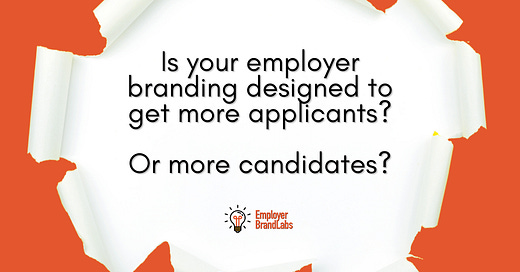This weekend, I posted something on LinkedIn about how there are only two employer brand strategies:
Be the Only something (the only law firm to offer a four-day work week, the only data science company to offer employees autonomy, the only startup that vests stock immediately, the only bank that will pay your student loans, etc)
Be the Most something (the agency that allows you to work with the biggest names, the law firm with the shortest path to partner, the startup with the most angel funding, the bank with the most time off, etc).
First, I stand by this idea because I think branding is the means by which you understand and communicate why people should engage with you. It is the isolation and amplification of what makes you interesting (meaning: deserving of your attention, even if only for a moment) which leads to the action you want.
A statement that simple and binary got some pushback, so I want to break things down so you could see my point.
First, if your strategy isn’t to stand out by being the best or most of something, what’s left? To not stand out? To not differentiate? It isn’t crazy. There are plenty of firms who seem to be doing ‘okay’ despite the fact that I couldn’t tell them apart if you paid me. There’s a survival-mechanism approach to “fitting in” and being “yet another” something, but that goes against what branding is for. Do you want to hire the person who applied for 20 similar-sounding companies or the person who saw something interesting and meaningful in you and so desires to be a part of what you’re doing?
Put another way, do you want an applicant? Or do you want a candidate?
Second, I heard from multiple people that this was an oversimplification because people choose a new job based on lots and lots of criteria and that this model didn’t allow for the kind of complicated decision-making that people need to make such an important selection. (People seemed insulted by this post, which really surprised me.) And I agree that a new job is a life-altering choice and it is based on a host of factors. But why did the person apply in the first place? What caused them to click on YOUR job posting in a sea of similar-sounding and looking roles? The core idea of your brand; the way in which you are the Only or the Most something. I would expect that you and your hiring manager and your company fill in all the gaps around salary and benefits and culture and working experience and all that, but if you’re not the Most or Only something, why did they apply in the first place? Because you were the twelfth search result when they typed their job title in LinkedIn jobs? I wouldn’t expect so.
Third, I heard people say that it would be impossible to be the Only or Most when there are millions of companies. And that’s a fair point.
But we need to take into account that not every business is offering every job. And not every person can work for any company. The strategy assumed that you are the Most or the Only among possible working situations. Meaning, if you’re hiring a nurse, you need to be a Most of Only relative to a dozen hospitals and clinics in the geographic area where a given nurse might consider looking. If you’re hiring a project manager, you’re competing against other companies that need that kind of PM so you need to be a Most or an Only against a hundred firms.
That’s achievable, right?
Look, you and your life partner didn’t come together by accident. You thought they were the Only clever person at that party and they thought you were the Most amusing person in the room. For a brief moment, you were each other’s Most and Only. That spark is what allowed you to get through dates where you each learned more about the other (perhaps even overcoming some semi-embarrassing revelations), leading to being together.
I mean, you didn’t date them just because there were there, did you? Did they??? They didn’t think you were the fifth cleverest person in the room and you thought they were the eighth-cutest person there. You saw something compelling in them and they in you.
Strategy is how you position yourself to your advantage. Being a Most or Only makes that happen. Everything else is just existing and hoping something good happens.
But here’s the issue: hope isn’t a strategy.
So don’t hope. Build a strategy that works for you.
+++++
I took my article on “what I learned by looking at 1,200 employer brand social media posts” and baked in examples of what’s not working and how I’d fix them. You know, to make it more actionable.
Want to read it? Boom. Enjoy!
***This Newsletter Contains No ChatGPT***
###





